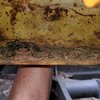I got the forward track line installed today. T and G Hydraulics made up the lines with the banjo fittings to match up to the track lever control fittings and I got the line in by running it in a new place (the bundle was too tight and the fitting would get stuck when I tried to pull it through). I filled the line with oil before connected the upper end at the control valve, as I did with the pilot line yesterday and tightened it down.
Note that I use an air compressor to blow all the lines out before installation, to avoid any metal filings getting into the system.
Unlike yesterday however, when I run the machine, the hydraulics are making a loud whirring noise. When I travel, the movement of the tracks is jerky, sort of a go-stop-go movement. I thought, despite adding ten gallons of fluid in the past week that maybe it's low on fluid, but there is still fluid in the tank when I look in there. No doubt SOME air got in the system, but when this happened after the first line change, it cleared up in 30 seconds and was running smoothly after that.
I need to flush the system and change filters real soon, but I've been neglecting my duties at the amp repair shop for the past three days due to dealing with the line replacements and I need to get back to paid work.
I'm going to try to get some more hydraulic fluid tomorrow, if Levine is open on Sat. or else will have to pay $11 more at AutoZone.
Is it likely air in the system that's making it noisy and jumpy? Recommended method to blead the air?

